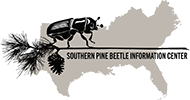Abstract
Key message: Increasing water use patterns were more spatially restricted than increased nitrogen in leaves and litterfall in mid-canopy sweetgum trees of varying proximity to overstory pines undergoing mortality.
Ecosystem changes following selective mortality of individual trees can be difficult to predict and depend on the response of surviving trees in the ecosystem. In the southeastern United States, southern pine beetle (Dendroctonus frontalis Zimmermann) selectively attacks and kills southern pines, particularly loblolly pine (Pinus taeda L.) which is prevalent throughout the region. Loss of loblolly pine should alter water and nutrient cycling unless co-occurring species are able to compensate for this lost functioning. The goals of this study were to determine changes in water and nutrient uptake of sweetgum trees (Liquidambar styraciflua L.) adjacent to loblolly pines experiencing mortality from girdling. We found that sweetgums near girdled pines initially used significantly less water, then similar amounts of water, then more water than sweetgums near control pines as pines experienced mortality. Relationships between daily sapflow and the natural log of vapor pressure deficit also differed significantly across years in sweetgums near girdled pines but not sweetgums near control pines. For sweetgum trees in both locations, both leaf and litterfall nitrogen content were significantly higher in the pine mortality year compared with the previous pine girdling year. Together, these results suggest that changes in water use are more spatially restricted to the region near dying pines whereas sweetgums, regardless of location, benefited from the extra available nitrogen in the ecosystem.
Keywords
Disturbance, Sapflow, Pinus taeda, Nutrient cycling, Succession
To read the full article please visit the link below:
Hornslein, Nicole J., Courtney Siegert, and Heidi J. Renninger. 2019. “Physiological Response of Mid-Canopy Sweetgum Trees to Overstory Loblolly Pine Mortality.” Trees-Structure and Function 33 (1): 139–51. https://doi.org/10.1007/s00468-018-1764-2.
